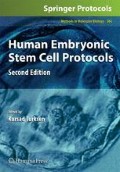Abstract
Peripheral somatic sensory neurons (PSNs) are responsible for the critical function of transmitting multiple modalities of information from the outside world, including heat, touch, and pain, as well as the position of muscles required for coordinated voluntary movement to the central nervous system. Many peripheral neuropathies exist, including hereditary neurodegeneration in Familial Dysautonomia, infections of PSNs by viruses such as Varicella zoster and damage to PSNs and/or their process resulting from other disease conditions such as diabetes. Understanding of the etiology of these diseases and development of treatments is hampered by the lack of normal and healthy human PSNs for study, which are only available from abortuses or rare surgical procedures.
Human embryonic stem cells (hESCs) are an ideal source of cells for generating normal PSNs for study of disease and drug development, since they can be grown virtually indefinitely in tissue culture and have the potential to form any cell type in the body. Several years ago, we generated human neurons with the molecular characteristics of PSNs from hESCs at low (less than 1%) yields (Pomp et al., Stem Cells 23:923–930, 2005). The present chapter details our most recently improved method that uses 2 rounds of PA6-induction to rapidly generate PSNs at more than 25% purity (Pomp et al., Br. Res. 1230: 50–60, 2008).
The neural crest (NC) is a transient multipotent embryonic stem cell population that is the source of PSNs. NC cells give rise to diverse and important tissues in man, but human NC has not been studied because of the difficulty in obtaining 3–5 week human embryos. The methods described in this chapter can also be used to quickly generate large numbers of human NC for study.
Access this chapter
Tax calculation will be finalised at checkout
Purchases are for personal use only
References
R.N. Singh, T. Nakano, L. Xuing, J. Kang, M. Nedergaard, and S.A. Goldman, (2005) Enhancer-specified GFP-based FACS purification of human spinal motor neurons from embryonic stem cells, Exp. Neurol. 196: 224–234.
N.S. Roy, C. Cleren, S.K. Singh, L. Yang, M.F. Beal, and S.A. Goldman, (2006) Functional engraftment of human ES cell-derived dopaminergic neurons enriched by coculture with telomerase-immortalized midbrain astrocytes, Nat. Med. 12: 1259–1268.
O. Pomp, I. Brokhman, I. Ben-Dor, B. Reubinoff, and R.S. Goldstein, (2005) Generation of peripheral sensory and sympathetic neurons and neural crest cells from human embryonic stem cells, Stem Cells 23: 923–930.
H. Kawasaki, K. Mizuseki, S. Nishikawa, S. Kaneko, Y. Kuwana, S. Nakanishi, S.-I. Nishikawa, and Y. Sasai, (2000) Induction of midbrain dopaminergic neurons from ES cells by stromal cell-derived activity, Neuron 28: 31–40.
K. Mizuseki, T. Sakamoto, K. Watanabe, K. Mugruma, M. Ikeya, A. Nishiyama, A. Arakawa, H. Suemori, N. Nakatsugi, H. Kawasaki, F. Murakami, and Y. Sasai, (2003) Generation of neural crest-derived peripheral neurons and floor plate cells from mouse and primate embryonic stem cells., Proc. Natl. Acad. Sci. USA 100: 5828–5833.
I. Brokhman, L. Gamarnik-Ziegler, O. Pomp, M. Aharonowiz, B.E. Reubinoff, and R.S. Goldstein, (2008) Peripheral sensory neurons differentiate from neural precursors derived from human embryonic stem cells, Different 76.
H. Kitajima, S. Yoshimura, J. Kokuzawa, M. Kato, T. Iwama, T. Motohashi, T. Kunisada, and N. Sakai, (2005) Culture method for the induction of neurospheres from mouse embryonic stem cells by coculture with PA6 stromal cells, J. Neurosci. Res. 80: 467–474.
N.M. LeDouarin, and C. Kalcheim, (1999) The Neural Crest, Cambridge University Press, Cambridge.
G. Lee, H. Kim, Y. Elkabetz, S.G. Al, G. Panagiotakos, T. Barberi, V. Tabar, and L. Studer, (2007) Isolation and directed differentiation of neural crest stem cells derived from human embryonic stem cells, Nat. Biotechnol. 25: 1468–1475.
X. Jiang, Y. Gwye, S.J. McKeown, M. Bronner-Fraser, C. Lutzko, and E.R. Lawlor, (2008) Isolation and characterization of neural crest stem cells derived from in vitro differentiated human embryonic stem cells, Stem Cells Dev. (available online doi: 10.1089/Scd. 2008. 0362).
J.A. Thomson, J. Itskovitz-Eldor, S.S. Shapiro, M.A. Waknitz, J.J. Swiergiel, et al., (1998) Embryonic stem cell lines derived from human blastocysts, Science 282: 1145–1147.
C.A. Cowan, I. Klimanskaya, J. McMahon, J. Atienza, J. Witmyer, J.P. Zucker, S. Wang, C.C. Morton, A.P. McMahon, D. Powers, and D.A. Melton, (2004) Derivation of embryonic stem-cell lines from human blastocysts, N. Engl. J. Med. 350: 1353–1356.
G.W. Conrad, J.A. Bee, S.M. Roche, and M.A. Teillet, (1993) Fabrication of microscalpels by electrolysis of tungsten wire in a meniscus, J. Neurosci. Methods 50: 123–127.
O. Pomp, I. Brokhman, L. Ziegler, M. Almog, A. Korngreen, M. Tavian, and R.S. Goldstein, (2008) PA6-induced human embryonic stem cell-derived neurospheres: a new source of human peripheral sensory neurons and neural crest cells, Br. Res. 1230: 50–60.
Acknowledgments
Our thanks to Chaya Morgenstern for her devoted technical and logistic help that enabled us to perform these experiments. Supported by the Israel Academy of Sciences grant 158/07, Chief Scientist's Office of the Ministry of Health/Public Committee for Allocation of Estate Funds, Ministry of Justice, Israel, the Dr. Miriam and Sheldon Adelson Medical Research Foundation, and the Taubenblatt Foundation to RSG.
Author information
Authors and Affiliations
Editor information
Editors and Affiliations
Rights and permissions
Copyright information
© 2009 Humana Press, a part of Springer Science+Business Media, LLC 2006
About this protocol
Cite this protocol
Goldstein, R.S., Pomp, O., Brokhman, I., Ziegler, L. (2009). Generation of Neural Crest Cells and Peripheral Sensory Neurons from Human Embryonic Stem Cells. In: Turksen, K. (eds) Human Embryonic Stem Cell Protocols. Methods in Molecular Biology, vol 584. Humana Press. https://doi.org/10.1007/978-1-60761-369-5_15
Download citation
DOI: https://doi.org/10.1007/978-1-60761-369-5_15
Published:
Publisher Name: Humana Press
Print ISBN: 978-1-60761-368-8
Online ISBN: 978-1-60761-369-5
eBook Packages: Springer Protocols

